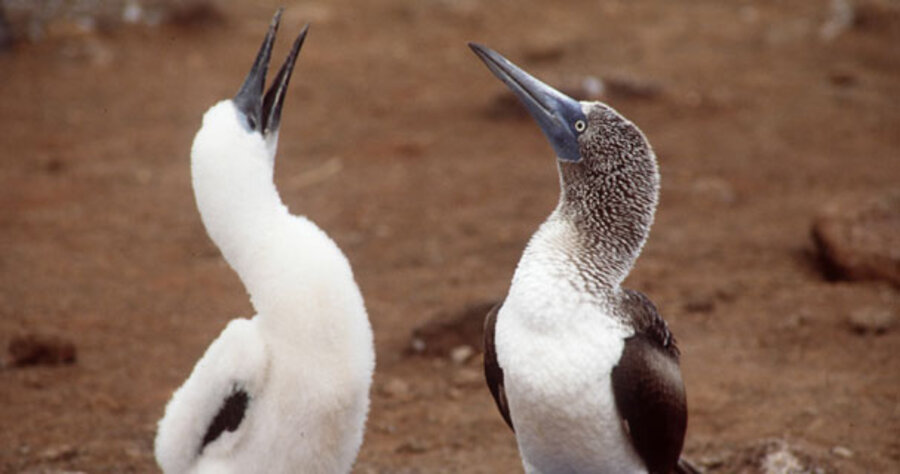A rainbow of Galapagos wildlife
Loading...
I roll the die in the Trivial Pursuit game and move to a green space; the category is science and nature. Question: What huge reptile lives over 100 years? I answer “Galapagos tortoise” and add a green scoring wedge to the round token.
But what if the question had been different? Maybe: What birds of the Sulidae family are masked or have either blue or red feet? What are the colors of a Sally Lightfoot crab? Where in the world does the only marine iguana live?
Before my recent visit to the Galapagos Islands, I wouldn’t have known the answers to those questions.
During the week-long voyage, we traveled in inflatable Zodiacs from our ship to seven of the islands – each with a different topography. An expert naturalist accompanied every group of approximately 16 passengers and shared astounding facts about the flora and fauna.
Several birds were especially endearing: Nazca boobies, including one adult next to its fluffy, white, and open-beaked chick; blue-footed boobies; fork-tailed courting male frigate birds with their expanded red gular sacs; and a rookery of Galapagos penguins, which zoomed by with their heads above the water less than five feet from our craft. They looked a bit like ducks speed racing.
The Sally Lightfoot crab, a decapod named by sailors for a Spanish dancer, is easy to detect near the rocky shore because of its vivid red-orange, turquoise, and gold colors.
Immediately, I knew I had to make a choice: Decorate a room in my house in those colors or knit a scarf with them.
Still, I knew that the finished product around my neck wouldn’t come anywhere near to matching nature’s astonishing color scheme.
Awed as I was by the birds and crustaceans, it was the iguanas that intrigued me most. I’d never been particularly keen to see iguanas – even at the zoo where they are enclosed behind glass.
Now, in their natural surroundings, not only did they appear unafraid of me, but surprisingly, I did not feel apprehensive being very close to them. A friend snapped a photo of me on all fours with a horde of iguanas nearby.
I saw not only the solitary land iguanas but also multitudes of the more gregarious marine species. Both types of lizards bob their heads to mark their territory, and several of us travelers pantomimed this when we were back onboard the boats.
Congregations of black marine iguanas basked on lava rocks as black as themselves. They were completely motionless – like artistic sculptures.
Soon afterward, we visited another island where the iguanas were easier to spot. They were no longer exclusively black but had red, green, and yellow markings on their scaly bodies.
Land iguanas are even flashier – some sport bright yellow mohawks in hopes of attracting females.
Fernandina Island, more than 690 miles from the northwestern coast of South America, is the headquarters for the world’s only truly marine lizard. Escorted tourists arrive on this island armed only with water bottles, sun hats, and cameras to shoot photos of these magnificent creatures.
I found it hard to take bad pictures of these striking animals. They look fanciful – like miniature versions of dragons imagined by the Brothers Grimm and Hans Christian Andersen.
I soon realized the story of the survival of reptilian species on the Galapagos is no lighthearted fairy tale, though. Their continuing existence has often been under threat.
In the past, settlers disrupted the natural life cycle of endemic species, including the enormous Galapagos tortoises, which sailors stacked upside down on their shells in the cargo holds of ships to use for food during their journeys.
Some species originally on these islands have already become extinct. Others are teetering between the endangered and nonendangered lists. This is in spite of Ecuador’s new laws designed to protect Galapagos wildlife. The outcome is not certain, but at least the government is making an attempt.
I have now finished knitting my new scarf. And whenever anyone asks about its brilliant colors, I share information not only about the Sally Lightfoot crab that inspired the work but also about the amazing reptiles and birds I encountered on my Galapagos adventure.





